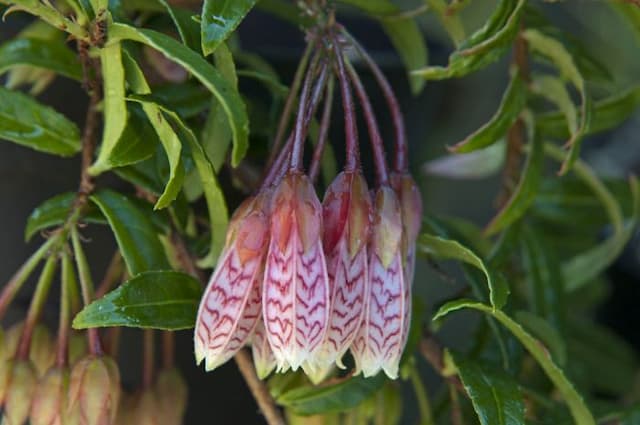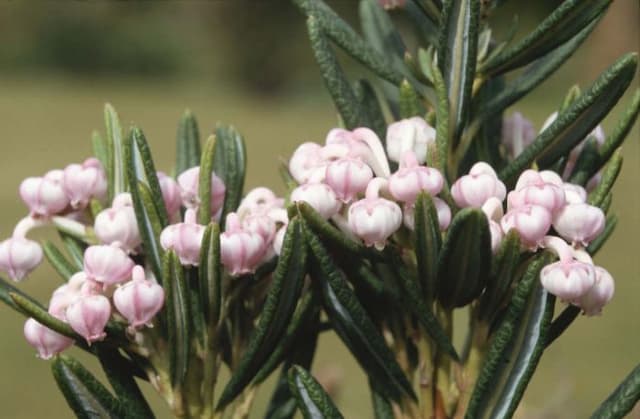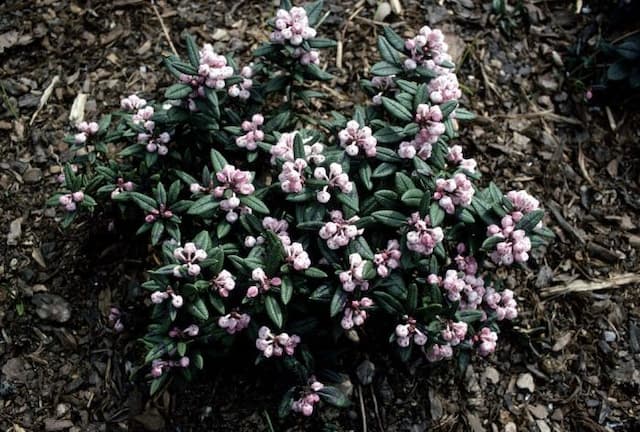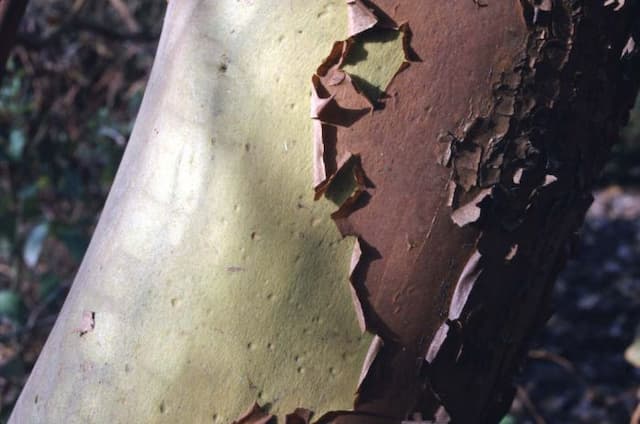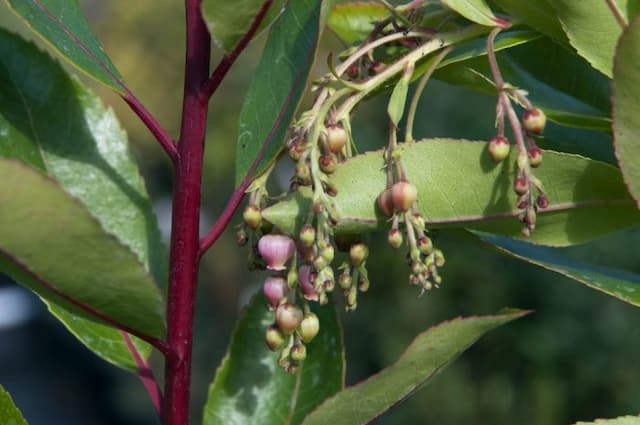Roxie's Rhododendron Rhododendron roxieanum var. oreonastes

ABOUT
The plant commonly known as Rhododendron features leaves that are noticeably small and leathery, lending a rather textured feel to the foliage. Typically, the leaves boast a deep, rich green hue that can appear almost glossy, accentuating the overall lush appearance of the plant. The undersides of the leaves are lighter, often with a soft, felty texture that stands in contrast to the smooth upper surface. When it comes to flowers, this plant truly shines, producing clusters of blooms that can range in color. The blossoms are bell-shaped and generally arranged in groups at the tips of the branches, creating a showy display that is quite eye-catching amidst the greenery. Each flower consists of several petals that fuse at the base, forming the characteristic shape that rhododendrons are known for. The structure of the plant itself tends to be quite dense and well-branched, giving rise to a compact appearance. The branches might also be noted for their smoothness, without the rough bark found on many other woody plants. This elegant form is one reason why the plant is a popular choice among gardeners and plant enthusiasts who appreciate both its floral beauty and its year-round foliage.
About this plant
 Names
NamesSynonyms
Oreonastes Rhododendron, Roxie's Rhododendron.
Common names
Rhododendron roxieanum var. oreonastes.
 Toxicity
ToxicityTo humans
Rhododendrons, including Rhododendron roxieanum var. oreonastes, contain toxic compounds known as grayanotoxins. If ingested, these can cause poisoning in humans, leading to symptoms such as nausea, vomiting, drooling, weakness, lethargy, hypotension (low blood pressure), sinus bradycardia (slower than normal heartbeat), and, in severe cases, potentially life-threatening cardiac complications. Care should be taken to avoid consuming any parts of the plant.
To pets
Rhododendrons, inclusive of Rhododendron roxieanum var. oreonastes, are toxic to pets due to the presence of grayanotoxins. If pets ingest any part of the plant, they may exhibit symptoms such as vomiting, diarrhea, drooling, weakness, incoordination, hypotension, seizures, coma, and in severe cases, it can be fatal. Immediate veterinary attention should be sought if a pet ingests rhododendron.
 Characteristics
CharacteristicsLife cycle
Perennials
Foliage type
Evergreen
Color of leaves
Green
Flower color
Varies
Height
5 feet (1.52 meters)
Spread
5 feet (1.52 meters)
Plant type
Shrub
Hardiness zones
7
Native area
China
Benefits
 General Benefits
General Benefits- Landscape Aesthetics: Rhododendron roxieanum var. oreonastes, commonly known as Oreonastes Rhododendron, adds visual interest and beauty to gardens with its distinct foliage and striking blooms.
- Habitat Support: Serves as a habitat and food source for a range of insects, which in turn can attract birds and other wildlife to the garden.
- Pollinator Attraction: The vibrant flowers are appealing to pollinators like bees and butterflies, which are essential for the pollination of many plants and crops.
- Soil Erosion Control: The shrub's root system can help stabilise soil on slopes and hilly areas, reducing the risk of soil erosion.
- Seasonal Interest: Provides seasonal interest with its evergreen leaves and spring flowers, contributing to a year-round appealing garden.
- Cultural Significance: May have cultural and historical value in certain regions, being used in traditional landscaping or as part of heritage gardens and estates.
 Medical Properties
Medical PropertiesThis plant is not used for medical purposes.
 Air-purifying Qualities
Air-purifying QualitiesThis plant is not specifically known for air purifying qualities.
 Other Uses
Other Uses- Rododendron nectar is sometimes used by beekeepers to produce a unique type of honey known for its strong flavor.
- The leaves of Rhododendron can be used to make a natural dye, which yields colors from tan to brown depending on the mordant used.
- Wood from large Rhododendron species can be crafted into small items such as bowls, handles, or buttons, showcasing its fine grain when polished.
- Rhododendron flowers are sometimes used in floral arrangements and bouquets due to their vibrant colors and large, showy blooms.
- The plant's dense growth habit provides excellent shelter and nesting sites for birds and other small wildlife in a garden setting.
- Rhododendron is used in landscaping to stabilize soil and prevent erosion on slopes thanks to its extensive root system.
- In certain cultures, Rhododendron leaves have traditionally been used to brew tea, often during ceremonies or festivals.
- The striking appearance of Rhododendron when in bloom is employed in photography and art to capture the essence of spring and natural beauty.
- Fallen Rhododendron leaves form a natural mulch that can enrich the soil as they decompose, thereby benefiting the surrounding plant life.
- Rhododendrons are often planted in groupings to form a natural privacy screen or windbreak in residential gardens and parks.
Interesting Facts
 Feng Shui
Feng ShuiRhododendron is not used in Feng Shui practice.
 Zodiac Sign Compitability
Zodiac Sign CompitabilityRhododendron is not used in astrology practice.
 Plant Symbolism
Plant Symbolism- Beware: Rhododendron often symbolizes caution or danger due to the plant's toxic nature.
- Warning: Just like the previous symbolism, rhododendron signifies to be wary and alert to possible harm.
- Abundance: Some cultures view rhododendrons as symbolic of abundance and wealth due to their lush, full blooms.
- Beauty: The rhododendron’s attractive flowers can represent natural beauty and elegance.
- Survival: As rhododendrons can survive in harsh conditions, they are sometimes used to symbolize the ability to endure and sustain.
- Passion: In certain contexts, the intensity of the rhododendron's flowers can suggest fervor and intensity of feeling.
 Water
WaterFor the Rhododendron, it's important to maintain consistent moisture without over-watering. Water the plant deeply once a week to reach the roots, providing about one gallon of water for each plant. In dry or hot weather, increase watering frequency to twice a week, while ensuring that the soil is well-drained to prevent root rot. Adjust the watering schedule based on rainfall, reducing the amount when natural precipitation provides adequate moisture. During winter months, water less frequently, but do not let the soil become completely dry.
 Light
LightRhododendrons prefer dappled sunlight or part shade. They thrive in conditions where they can receive morning light but are protected from the harsh afternoon sun. The ideal spot for this plant is under the canopy of larger trees that can provide filtered light, shielding the rhododendron from direct sun exposure which can scorch the foliage.
 Temperature
TemperatureThis Rhododendron variety can tolerate a range of temperatures and is cold-hardy, but it prefers cooler conditions overall. Ideally, maintain an environment where temperatures remain between 40°F and 70°F for optimal growth. This rhododendron can survive temperatures as low as 5°F but ensure it's protected from harsh winter winds. Avoid exposing the rhododendron to temperatures above 80°F, which can cause stress to the plant.
 Pruning
PruningPrune rhododendrons to maintain shape and encourage bushier growth. The best time to prune is immediately after the blooming period ends in late spring, as this allows time for the new growth to mature and flower next season. Remove any dead or diseased branches, and if necessary, thin out over-crowded areas to improve air circulation. Pruning every year is not always required; only prune as needed based on the plant's appearance and health.
 Cleaning
CleaningAs needed
 Soil
SoilRhododendron roxieanum var. oreonastes, commonly known as Roxie's rhododendron, prefers a soil mix that is acidic, well-drained, and rich in organic matter. A suitable mix can be created with equal parts of peat moss, pine bark, and perlite to ensure good drainage and aeration. The ideal soil pH for Roxie's rhododendron should be between 4.5 and 6.0.
 Repotting
RepottingRoxie's rhododendron typically needs repotting every 2 to 3 years, or when its root system outgrows its current container. Spring is the best time to repot this plant, taking care to handle its delicate roots gently and to choose a pot only slightly larger than the previous one to avoid overpotting.
 Humidity & Misting
Humidity & MistingRoxie's rhododendron thrives in high humidity levels, ideally between 60% and 80%. To achieve optimal humidity for this plant indoors, a humidifier can be used, or the plant can be placed on a water-filled pebble tray to increase the ambient moisture around the foliage.
 Suitable locations
Suitable locationsIndoor
Keep Roxie's rhododendron in bright, indirect light indoors.
Outdoor
Plant Roxie's rhododendron in dappled shade outdoors.
Hardiness zone
7-9 USDA
 Life cycle
Life cycleRhododendron roxieanum var. oreonastes, more commonly known as Rhododendron, begins its life cycle with seed germination, which requires cold stratification, a process mimicking winter, to break dormancy. Germination takes place in moist, well-drained soils, often in partial shade environments. Once germinated, the seedlings develop into juvenile plants, establishing a root system and foliage through photosynthesis. As they mature, Rhododendrons enter a vegetative stage, producing evergreen leaves and woody stems, and can grow quite large depending on conditions. The reproductive phase follows, characterized by the blooming of showy flowers, usually in spring, which attract pollinators for sexual reproduction; the flowers vary in color and form clusters known as inflorescences. After pollination, seeds are produced and dispersed, completing the cycle and potentially giving rise to new plants if conditions are favorable.
 Propogation
PropogationPropogation time
Spring to Summer
The most popular method of propagation for Rhododendron roxieanum var. oreonastes, commonly known as Roxie's Rhododendron, is through semi-hardwood cuttings. This is typically done during the late summer months. Cutting selections are made from the current year’s growth, ensuring that each cutting is about 4 to 6 inches (10 to 15 centimeters) long with several leaves. The lower leaves are carefully removed, and the cut end is dipped in rooting hormone to encourage root development. The prepared cuttings are then placed in a well-draining medium, such as a mix of peat and perlite, and kept under high humidity and indirect light until roots have formed, which can take several weeks. During this period, it is important to maintain consistent moisture without allowing the cuttings to become waterlogged.
